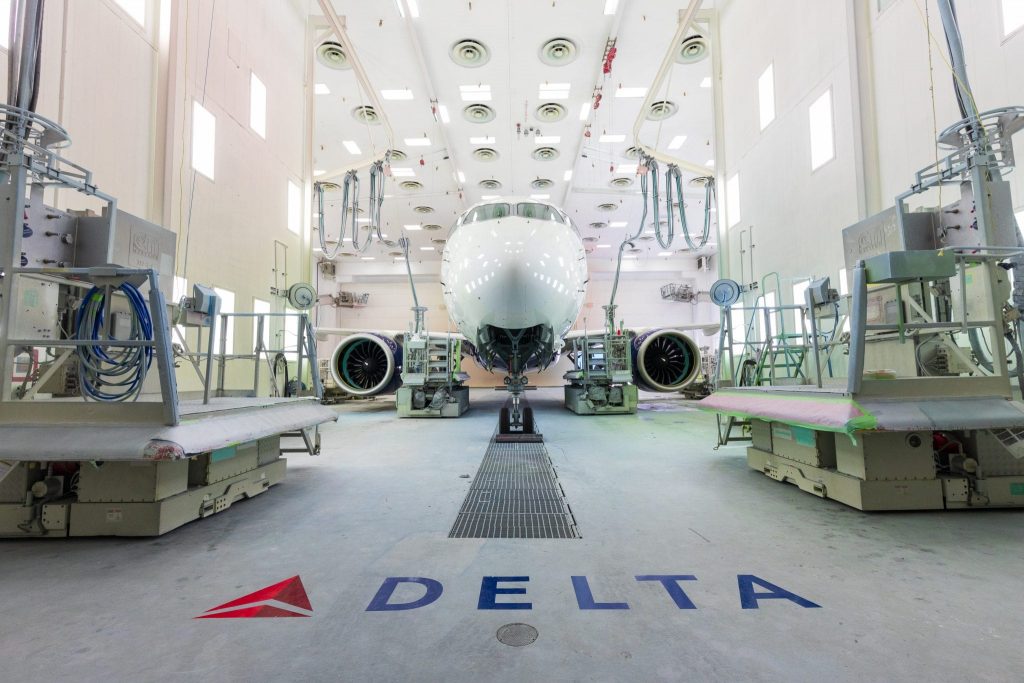Skift Take
All U.S. airlines are performing well. Demand is robust, and while fuel prices are up, they're not that high compared to historical levels. Delta is using that state-of-play to go on the offensive to win more share from its competitors.
Can an airline use its newest airplane to send a message to its competitors?
It’s a timely question after Delta Air Lines said Friday it plans to deploy its Airbus A220 — among the first truly new mainline narrow-body aircraft to hit the market in years — on routes where it competes with United Airlines, American Airlines and JetBlue Airways.
Between January — the first flight is Jan. 31 — and August, Delta will use the aircraft, which it claims feels more like a modern widebody aircraft than a short-haul jet, on nine routes, all touching the biggest hubs of its competitors. Five will go to the American Airlines mega-hub in Dallas/Fort Worth, three go to United’s Houston hub and one goes to JetBlue’s Boston focus city,
On four of the nine routes, Delta will fly the A220 not just on one or two flights, but on all departures, once it has enough jets. It has ordered at least 75.
Delta did not choose the routes by chance. It is by most accounts the most profitable and punctual U.S. airline, and while it performs well in its core markets, such as Atlanta, Detroit, New York and Los Angeles, Delta is looking to expand by adding share elsewhere, including from its competitors. By flying its newest jets against what are in many cases older airplanes, sometimes operated by regional airlines, it is likely betting it can win new customers, particularly premium customers.
“They are going to poke the bear,” said Robert Mann, an industry consultant. “They are running an excellent operation. They are extracting a significant amount of corporate and premium revenue in the domestic market. They are going to take some more from Dallas and Houston, and from JetBlue in Boston. It is going to be the new standard bearer, and they are going to scrape as much premium revenue from a premium airplane as they can.”
Competitive Advantage
Delta is not the launch customer for the aircraft, a plane that had been called the Bombardier C Series until Airbus took over the program this summer.
Swiss has flown it for more than two years, but Delta will be the first North American operator, and the airline is embarking on a major marketing campaign to tout it.
Delta’s A220-100s will feature 109 seats, including 12 in first class, and 15 in Comfort Plus, the airline’s extra-legroom section. It’ll also have seat-back screens — rare for such small airplane — as well as high-speed Wi-Fi, large windows, big overhead bins, and the widest coach seats on a Delta narrowbody aircraft. And because it has a two-by-three configuration, the A220s has fewer middle seats than most planes.
Within a couple of years, JetBlue, Air Canada and David Neeleman’s U.S. startup are expected to have it. But for now, it is a competitive advantage for Delta.
Play for Corporate and Premium Travelers
While most travelers prefer newer, nicer cabins, passengers generally choose fares based on price, not comfort, particularly on shorter flights.
But business travelers can be the exception, as corporate travel policies don’t always require them to book the cheapest option. They may go out of their way to fly the most comfortable flatbed business class seat, or, in this case, the newest domestic airplane.
Mann said he does not expect American to make moves to try to fend off Delta’s challenge. Still, he suggested American, which may be the weakest of the three major U.S. network carriers — its stock price has plunged roughly 41 percent this year — improve its customer service and on-time performance. “Until they do, these sorts of moves by Delta will just skim off the cream, even more of it,” he said.
At an investor event last month, Delta executives said the airline retains a 19 percent unit revenue premium compared to its domestic competitors, up from 6 percent in 2010, and 16 percent in 2016. Essentially, that means customers are paying more to fly Delta.
“Where does that come from?” Mann said. “It comes by eating other peoples’ lunch. We are not talking about ham and cheese. We are talking about the really premium 21 Club Burger. That 19 percent comes right out of American’s top line and right out of United’s top line. It is a 19 percent premium over the rest of the industry. I have never seen a number that big.”
The Daily Newsletter
Our daily coverage of the global travel industry. Written by editors and analysts from across Skift’s brands.
Have a confidential tip for Skift? Get in touch
Tags: airbus, airline innovation, american airlines, delta air lines, jetblue airways, united airlines
Photo credit: Delta is using its new Airbus A220 as leverage against the competition. The aircraft will enter revenue service in January. Delta Air Lines
